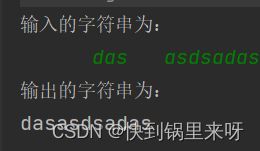详解next().nextLine().hasNext().hanNextLine()
目录
1.next()和nextLine()
1.1 next()
1.2 nextLine()
1.3 next()和nextLine()方法连用
2.hanNext()和hasNextLine()
2.1 hasNext()
2.2 hasNextLine()
2.3 特别强调有位博主这块讲的是真的细节
1.next()和nextLine()
nextLine和next都是读取输入台输入的字符。
1.1 next()
next()在读取到有效字符前,遇到空格、tab、回车等会自动忽略,直到读取有效字符后,再次遇到空格、回车、tab 会停止读取
public static void main(String[] args) {
Scanner sc = new Scanner(System.in);
String str1 =null ;
System.out.println("输入的字符串为:");
str1 = sc.next();
System.out.println("输出的字符串为:");
System.out.println(str1);
}1.2 nextLine()
nextLine()读取的是回车前的所有字符,包括空格、tab
public static void main(String[] args) {
Scanner sc = new Scanner(System.in);
String str1 =null ;
System.out.println("输入的字符串为:");
str1 = sc.nextLine();
System.out.println("输出的字符串为:");
System.out.println(str1);
}1.3 next()和nextLine()方法连用
(1)如果nextLine()在next()前面
public static void main(String[] args) {
String s1,s2;
Scanner sc=new Scanner(System.in);
System.out.print("请输入第一个字符串:");
s1=sc.nextLine();
System.out.print("请输入第二个字符串:");
s2=sc.next();
System.out.println("输入的字符串是:"+s1+" "+s2);
}可以看到输出是没有问题的
(2)如果next()在nextLine()前面
public static void main(String[] args) {
String s1,s2;
Scanner sc=new Scanner(System.in);
System.out.print("请输入第一个字符串:");
s2=sc.next();
System.out.print("请输入第二个字符串:");
s1=sc.nextLine();
System.out.println("输入的字符串是:"+s1+" "+s2);
}这就会发现next输入完成后,到nextLine就会自动把next去掉的回车读取出来 ,从而没办法输入s2.
⚜️ 那么如何解决这个问题呢
public static void main(String[] args) {
String s1,s2;
Scanner sc=new Scanner(System.in);
System.out.print("请输入第一个字符串:");
s1=sc.next();
sc.nextLine();
System.out.print("请输入第二个字符串:");
s2=sc.nextLine();
System.out.println("输入的字符串是:"+s1+" "+s2);
}可以发现在next后,连续使用了两次nextLine,第一个nextLine是为了把next去掉的回车读取了,第二个nextLine才是为了输入字符串
所以以后next和nextLine连用,并且next先使用的话,那就要两次nextLine
2.hanNext()和hasNextLine()
hanNext()和hanNextLine()都是用于判断有无键盘输入的,有则返回true,没有则阻塞
2.1 hasNext()
hasNext()经常用于判断是否还有输入的数据,也就是非空字符
比如说将hasNext()放在while()循环中,如果还要输入那就返回true,如果没有则阻塞(阻塞就是一直停留在判断阶段),由此来判断是否还有需要输入的数据。
public static void main(String[] args) {
Scanner sc = new Scanner(System.in);
String[] str = new String[5];
int i = 0;
while (sc.hasNext()) {
str[i] = sc.next();
i++;
for (int j = 0; j < i; j++) {
System.out.println(str[j]);
}
}
}可以发现每一个字母后都有空格,而next遇到空格后,停止读取,这时hasNext就体现出作用了,检查是否还有要输入的,
2.2 hasNextLine()
hasNextLine() 方法会根据行匹配模式去判断接下来是否有一行(包括空行),如果有,则返回true
public static void main(String[] args) {
Scanner sc = new Scanner(System.in);
System.out.println("使用nextline方式接收字符串:");
//判断用户有没有输入字符串
if(sc.hasNextLine()){
String s = sc.nextLine();
System.out.println("输出的内容为:"+s);
}
sc.close();
}2.3 特别强调有位博主这块讲的是真的细节
如果看完我前面写的,对这块还是有疑问,大家可以看下这个博主的这篇文章,写的真的特别好
hasNext、hasNextLine、next、nextLine保姆级详解






